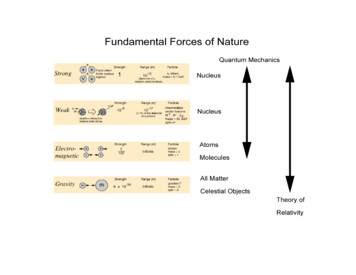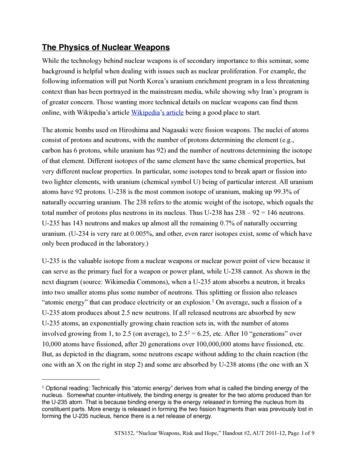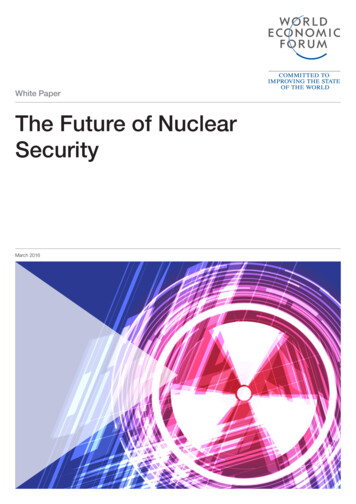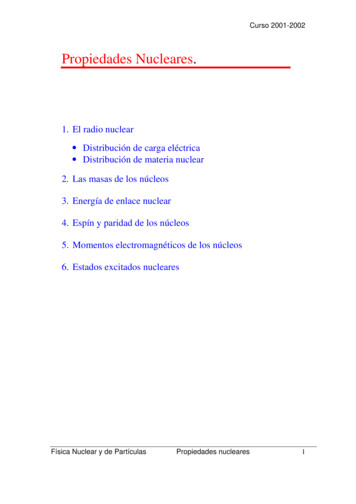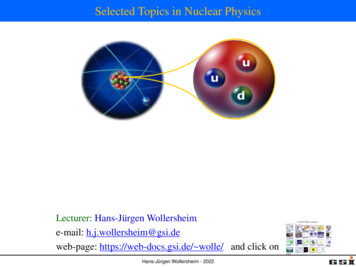
Transcription
Selected Topics in Nuclear PhysicsLectures: Hans-Jürgen Wollersheime-mail: h.j.wollersheim@gsi.deweb-page: https://web-docs.gsi.de/ wolle/and click on1. Nuclear properties (K. Hyde)2. Liquid drop model (K. Hyde)3. Types of nuclear reactions4. Counting statistics and error propagation (G. F. Knoll)5. Properties of radiation detectors(efficiency especially) (G. F. Knoll)6. Nuclear Shell model(K. Hyde)7. Nuclear physics at extremes of stability : Exotic nuclei (Isomers especially) (K. Hyde)https://gsi-fair.zoom.us/j/9087586690Meeting ID: 908 758 6690Password: passwordHans-Jürgen Wollersheim - 2020
Literature Recommended Textbook Supplemental Textbookwww.bookzz.orgHans-Jürgen Wollersheim - 2020
neutron starunstable nucleisupernovaesunheavy ionnuclear reactionsHans-Jürgen Wollersheim - 2020
Brief historical overviewin search of the building blocks of the universe .Greek philosophers4 building blocksearthairwaterfire5th BC - Democritusatomic hypothesis18th – 19th century Lavoisier, Dalton, .put atomic hypothesis on firm basisdistinction between compounds and pure elements1896 Dmitri Mendeleev92 building blocks(chemical elements)1H, 2He,. 92UHans-Jürgen Wollersheim - 2020
Brief historical overviewin search of the building blocks of the universe .1896 Henri Becquereldiscovers ion of radiation from atoms3 types observed: α, β and γα and β deflected in opposite directionopposite chargesα deflected less than βα must have larger massγ not deflecteduncharged 1900 Ernest Rutherfordelectron“. it was as incredible as if you hadfired a 15-inch shell at a piece of tissuepaper and it came back and hit you”investigates new radiationα and β emissions change nature of elementα‘s charge 2eα‘s mass 4Hβ radiation electronsγ electromagnetic radiation (photons)1911 Ernest Rutherford tests Thomson’s model of the atomN electrons (-e·N) embedded in ( e·N) chargeuniformly distributed over atomic volume“plum pudding model”Hans-Jürgen Wollersheim - 2020expectedα’s (2He) pushed a little to theside by charges of atom (79Au)observedsome α’s deflectedbackwards to 1800!!
Brief historical overviewin search of the building blocks of the universe1913 Niels Bohrplanetary model of atomall positive charges (and all mass)concentrated in tiny region at the center1920 Francis William Aston mass spectrograph1925 Werner Heisenbergmeasures masses of atomsmasschargeHe 4 HHe 2 HC 12 HC 6HO 16 HO 8H𝐸𝐸hypothesis of neutral particle in nucleus with m mpquantum mechanicsimplest atom Hits nucleus proton1932 James Chadwickdiscovers the neutron3 building blockselectron proton neutronNUCLEAR PHYSICSHans-Jürgen Wollersheim - 2020𝐵𝐵
Brief historical overviewin search of the building blocks of the universe1932 Enrico Fermideveloped the theory of β-decay1934 Irene Joliot-Curie & Frederic Joliotartificial radioactivity1934 Hans Bethe2713𝐴𝐴𝐴𝐴 42𝐻𝐻𝐻𝐻 30 15𝑃𝑃 1𝑛𝑛liquid drop model and mass formula1938 Otto Hahn, Lise Meitner & Fritz Strassmanndiscover nuclear fission1948 Maria Goeppert-Mayer & J. Hans D. Jensendevelop the nuclear shell modelHans-Jürgen Wollersheim - 2020
Brief historical overviewin search of the building blocks of the universe1953 Aage Niels Bohr, Ben Roy Mottelson, Leo James Rainwaterdeveloped the collective nuclear model1956 Frederick Reines & Clyde L. Cowandiscovery of the neutrino1983 Carlo Rubbiadiscovery of the W and Z Boson1998 Takaaki Kajita & Arthur B. McDonalddiscovery of neutrino oscillationsneutrinos must have some massHans-Jürgen Wollersheim - 2020
The Nobel Prizes in Physics (Chemistry)in the 20 and 21 centuries1903: Radioactivity (Henri Becquerel, Marie & Pierre Curie)1906: Discovery of electron (J. J. Thompson)1908: Disintegration of the elements (Ernest Rutherford)1922: Structure of atoms (Niels Bohr)1929: Wave nature of electrons (Prince Louis-Victor Pierre Raymond de Broglie)1935: Discovery of neutron (James Chadwick)1936: Discovery of positron (Carl David Anderson)1938: New radioactive elements produced by neutron irradiation (Enrico Fermi)1939: Cyclotron (Ernest O. Lawrence)1949: Theoretical work on nuclear forces (Hideki Yukawa)1951: Transmutation of atomic nuclei (John Douglas Cockcroft & Ernest Thomas Sinton Walton)1952: Nuclear Magnetic Resonance (Felix Bloch & Edward Mills Purcell)1957: Parity violation (Chen Ning Yang & Tsung-Dao Lee)1959: Discovery of antiproton (Emilio Gino Segre & Owen Chamberlain)1961: Electron scattering and resonance absorption (Robert Hofstadter & Rudolf Ludwig Mössbauer)1963: Nuclear shell model (Maria Goeppert-Mayer & J. Hans D. Jensen)1967: Nuclear reactions and energy production in stars (Hans Albrecht Bethe)1969: Quarks (Murray Gell-Mann)1975: Collective and particle motion (Aage Niels Bohr, Ben Roy Mottelson & Leo James Rainwater)1984: Discovery of W and Z bosons (Carlo Rubia & Simon van der Meer)1989: Development of ion trap technique (Hans G. Dehmelt & Wolfgang Paul)1992: Multi Wire Proportional Chamber (Georges Charpak)1995: Discovery of tau and detection of neutrino (Martin L. Perl & Frederick Reines)2008: CKM matrix element (Makoto Kobayashi & Toshihide Masukawa)2013: Theoretical work on origin of mass of subatomic particles (Francois Englert & Peter W. Higgs)2015: Discovery of neutrino oscillations (Takaaki Kajita & Arthur B. McDonald)Henri Becquerel1852-1908Nobel price 1903Marie Curie (1867-1934)Piere Curie (1859-1906)Nobel price 1903Hans-Jürgen Wollersheim - 2020
Discovery timeline1896: Henri Becquerel discovers radioactivity in Uranium salt1898: Marie & Pierre Curie discover Polonium and Radium (new elements)1907: Ernest Rutherford classified α-, β-, γ-radiation (α 4He nucleus)1911: Rutherford, Geiger and Marsden discovered the atomic nucleus1913: Bohr model of the hydrogen atom1919: first nuclear reaction by Rutherford 14N α 17O p1930: Ernest O. Lawrence invented the cyclotron1932: Enrico Fermi developed the theory of β-decay1935: Hideki Yukawa postulates the theory of strong interaction (pion)Bethe-Weizäcker mass formula & liquid drop model1938: Hans Bethe postulates CNO fusion reaction for stellar energy1939: O. Hahn, F. Straßmann and L. Meitner discover nuclear fission1946: F. Bloch and E. Purcell improve NMR technique1949: M. Goeppert-Mayer proposed the nuclear shell model1957: beginning of nuclear astrophysics (Burbidge2, Fowler, Hoyle-article to nucleosynthesis)1967: J. Bell and A. Hewish discover pulsars (neutron stars)1986: first observation of double-β decay 2νββ (rarest decay)2006: production of the so far heaviest element (element Z 118)Henri Becquerel1852-1908Nobel price 1903Marie Curie (1867-1934)Piere Curie (1859-1906)Nobel price 1903Hans-Jürgen Wollersheim - 2020
www.bookzz.org. Hans-Jürgen Wollersheim - 2020 neutron star. supernovae. sun. heavy ion. nuclear reactions. unstable nuclei. Hans-Jürgen Wollersheim - 2020 Brief historical overview in search of the building blocks of the universe . earth. water. air. fire. Greek philosophers. 4 building blocks. 5. th. BC - Democritus atomic hypothesis . 18. th - 19. th. century Lavoisier, Dalton .
